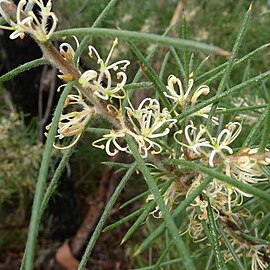Spreading shrub, hairy in most of its parts. Shoots terete, shaggy villous. Lvs simple, terete, 30-80 × 0.8-1.5 mm, villous at first and some hairs remaining, rigid and spiny. Fls solitary or few in fascicles. Pedicels 3-5 mm long, shaggy villous. Perianth white, sparsely hairy, < pedicel. Ovary stipitate; style glabrous; stigma large, oblique. Fr. 3.7-4.3 × (2.7)-3-3.5 cm, rugose, shortly beaked. Seed 30-33 × 10-14 mm (including wing), black; wing extending down both margins.
Shrub, much branched, up to 4 m high, shoots markedly hairy when young, glabrous later. Leaves needle-shaped, 80 mm long, sharp-pointed, grey-green to dark green, densely hairy when young, glabrous when mature. Flowers in leaf axils, pedicellate, cream-coloured. Flowering time June-Sept. Fruit a hard woody follicle, grey, 2 apical horns, rough, opening into 2 valves.
A bushy shrub or tree up to 4 m tall. Leaves needle-like, 40-80 mm long, 1-2 mm wide, tip sharply pointed, covered with dense, shaggy hairs when young, becoming hairless. Flowers dark cream. Follicles 20-35 mm long, 3 mm wide, with 2 sharp horns on the beaked tip, each growing at right angles to its stalk. Flowers: June to September.
Shrub or small tree to 4 m. Leaves needle-like, 40-80 mm long. Flowers axillary, cream-coloured. Fruits woody with knobs.


